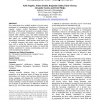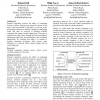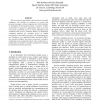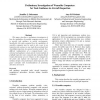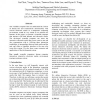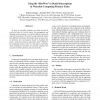ACMIDC
2010
14 years 7 months ago
2010
New technologies have enabled students to become active participants in computational simulations of dynamic and complex systems (called Participatory Simulations), providing a &q...
ISWC
1997
IEEE
14 years 8 months ago
1997
IEEE
While wearable computers are empowering fashion accessories, they bring with them a tangle of wares which connect their parts. As these subsystems begin to decouple and operate on...
ISWC
1997
IEEE
14 years 8 months ago
1997
IEEE
Situated computing concerns the ability of computing devices to detect, interpret and respond to aspects of the user’s local environment. In this paper, we use our recent protot...
ISWC
1998
IEEE
14 years 8 months ago
1998
IEEE
The use of speech and auditory interaction on wearable computers can provide an awareness of events and personal messages, without requiring one's full attention or disruptin...
ISWC
1998
IEEE
14 years 8 months ago
1998
IEEE
Most existing augmented reality systems only provide a method for browsing information that is situated in the real world context. This paper describes a system that allows users ...
ISWC
1998
IEEE
14 years 8 months ago
1998
IEEE
This paper describes a preliminary investigation of how the capabilities of wearable computers may be used to provide task guidance in mobile environments. Specifically, this stud...
ISWC
2003
IEEE
14 years 9 months ago
2003
IEEE
This paper presents results from a study examining the link between the functionality and the comfort of wearable computers. We gave participants two different devices to wear and...
ICAT
2003
IEEE
14 years 9 months ago
2003
IEEE
The wearable computer that can understand the context of human life and communicate autonomously with various electronic media in a ubiquitous computing environment would be very ...
ICDCSW
2005
IEEE
14 years 9 months ago
2005
IEEE
Displaying and navigating complex information on wearable computers is very different from accessing the same information while sitting at your desk. Limitations in hardware, scre...
ISWC
2006
IEEE
14 years 9 months ago
2006
IEEE
As users of wearable computers are often involved in real-world tasks of critical nature, the management and handling of interruptions is crucial for efficient interaction and ta...
